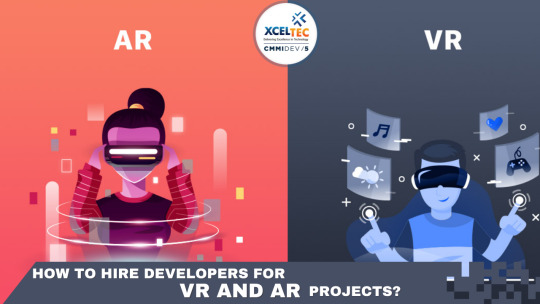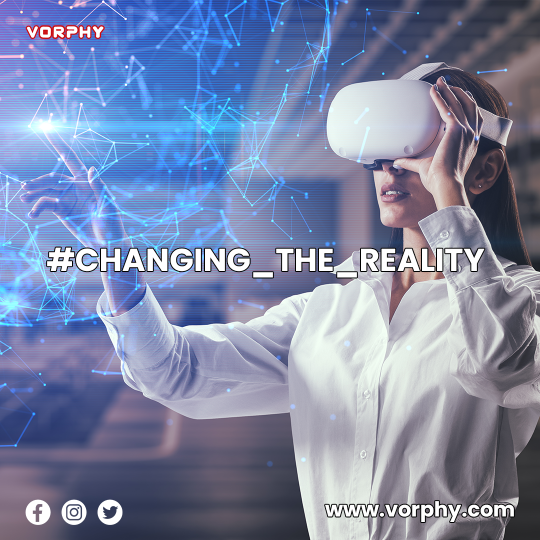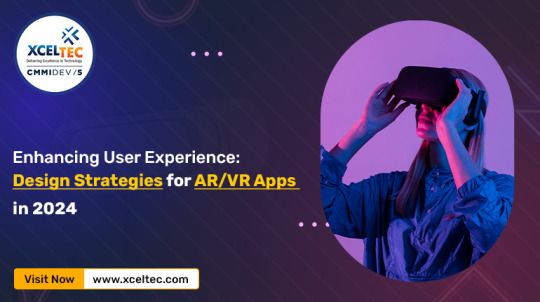#AR/VR Development
Text
The Advancement of AR/VR Development: Molding the Eventual fate of Vivid Encounters

In the domain of innovation, scarcely any developments have caught the creative mind very like Expanded Reality (AR) and Augmented Reality (VR). These extraordinary advancements have opened up new elements of human association, diversion, schooling, and business. From upgrading our existence with advanced overlays to submerging us in altogether virtual universes, AR and VR development keep on pushing the boundaries of what's conceivable. How about we dig into the advancement of AR/VR development and investigate how it's forming the eventual fate of vivid encounters.
The Beginnings:
The foundations of AR and VR development can be followed back a very long while. Early analyses laid the basis for what might ultimately become current AR and VR advances. In the late twentieth hundred years, researchers and trend-setters started investigating ways of making vivid advanced encounters. Notwithstanding, it was only after the early 2010s that AR and VR started acquiring standard consideration with the approach of gadgets like the Oculus Break and Google Glass.
Early Difficulties:
The early long stretches of AR/VR development were characterized by various specialized and viable difficulties. Establishing persuading virtual conditions required conquering issues connected with hardware constraints, movement affliction, and dormancy. Engineers needed to track down imaginative answers for advance execution and upgrade client experience.
Forward leaps and Developments:
Regardless of the difficulties, leap forwards in hardware and software made ready for huge progressions in AR/VR development. The presentation of additional strong designs handling units (GPUs), movement following sensors, and high-goal shows empowered engineers to make more vivid and reasonable encounters. Moreover, headways in PC vision, AI, and spatial registering advances improved the abilities of AR and VR applications.
Applications Across Enterprises:
AR and VR development have tracked down applications across a large number of enterprises, changing how we work, learn, and play. In the domain of schooling, these advancements offer vivid learning encounters that draw in understudies and work with more profound comprehension of complicated subjects. In healthcare, AR/VR arrangements are being utilized for clinical preparation, careful recreations, and treatment. Media outlets has embraced AR and VR for gaming, narrating, and vivid encounters, for example, virtual shows and amusement park attractions. In addition, AR/VR innovation is upsetting retail by empowering virtual take a stab at encounters and vivid item shows.
The Ascent of Blended Reality (MR):
As AR and VR advancements keep on developing, we're seeing the rise of Blended Reality (MR), which mixes components of both genuine and virtual universes. MR encounters consistently coordinate computerized satisfied with the actual climate, offering clients a more vivid and intelligent experience. Microsoft's HoloLens and Sorcery Jump's Enchanted Jump One are instances of MR gadgets that are pushing the boundaries of spatial processing and intelligent holographic presentations.
Future Viewpoint:
The eventual fate of AR/VR development is overflowing with potential outcomes. As hardware turns out to be all the more impressive and reasonable, we can hope to see significantly more prominent reception of vivid advances across various areas. Further developed calculations and computer based intelligence driven progressions will upgrade the authenticity and intuitiveness of AR and VR encounters. Moreover, the combination of AR/VR with other arising advancements, for example, 5G, edge registering, and the Web of Things (IoT) will open new open doors for development and cooperation.
End:
AR and VR development have made some amazing progress since their commencement, and they keep on reclassifying how we see and connect with the computerized world. With each mechanical jump forward, we inch more like a future where vivid encounters are flawlessly incorporated into our regular routines. As designers and pioneers keep on pushing the boundaries of what's conceivable, one thing is sure: the excursion towards really vivid and intuitive encounters is far from over. AR and VR are not simply innovations; they are windows into a future where the line between the genuine and the virtual hazy spots, opening up vast opportunities for investigation and revelation.
0 notes
Text
#technology#appdevelopment#development#developers#application#software#mobileappdevelopment#mobileappdevelopers#mobile app developer company#mobile app developers#mobileappdesign#b2b#AI#ai software development company#AR/VR development
0 notes
Text
Top Five Frameworks for cross-platform App development

AR developers will mostly require:
familiarity with the major virtual reality platforms, operating systems, and developer tools
superior computer vision abilities. 3D modeling (texturing, shading, and rendering) knowledge of desktop, online, or mobile programming
The following are the most prominent desktop tools used by VR developers:
3D engine Unity. Unity 3D, which began as a game engine, now includes a plethora of 3D, 2D, and other libraries and features. It enables rapid VR app prototyping, app design in a virtual environment, rapid iterative development, and exporting to practically any platform: Android, iOS, Windows, Oculus Rift, Steam VR, Playstation VR, Microsoft HoloLens, and so on. This gaming engine provides a plethora of complex functions and graphics.
The Unreal Engine. This gaming engine includes a plethora of innovative features and graphics to provide the most realistic imagery and gaming experience possible.
Blender. This is a free solution for Windows, Linux, and Mac OS. It's fantastic for modeling, mapping, and animation.
SketchUp is a program created by Google. This virtual reality development environment makes it easier to create VR/AR apps for interior design, civil engineering, architecture, and landscape design.
Nowadays, Unity is likely the most popular VR development platform. Among other things, it works with all major platforms and device manufacturers and provides high-quality frame rates.
A number of features are combined with a versatile VR/AR API.
Why Build for AR/VR with XcelTec?
When creating AR, VR, and MR solutions, creativity and intelligence set you apart from the competitors. Our AR/VR Development team combines creativity and potential talents to produce innovative and wonderful user experiences with each app they create. As a result, you should engage with the best AR developers in India if you want to implement AR & VR technologies into your business processes. XcelTec is aware of your difficulties when conducting a thorough evaluation.
Visit to explore more on How to Hire developers for VR and AR projects?
Get in touch with us for more!
Contact us on:- +91 987 979 9459 | +1 919 400 9200
Email us at:- [email protected]
#dedicated ar/vr developers#hire ar developers#hire vr developers#AR/VR developers#AR/VR Development
0 notes
Text
#theintellify#mobile application development#web application development#cloud consulting services#augmented reality#virtual reality#ar vr technology#arvr#ar vr development company#ar vr development services
2 notes
·
View notes
Text

#IFTTT#Giphy#giphyupload#3d#vr#ar#development#unreal#virtualreality#unreal engine#xr#motion capture#ue5#animaiton
2 notes
·
View notes
Text
ArccusIns is a leading IT company that provides a wide range of services, including web engineering, enterprise mobility, UI & UX development, technology consulting, and digital marketing. We help businesses of all sizes transform their digital presence and achieve their business goals.
Our team of experienced professionals has a deep understanding of the latest technologies and trends. We work closely with our clients to understand their needs and deliver solutions that are tailored to their specific requirements.
ArccusIns is a leading IT company that provides a wide range of services, including web engineering, enterprise mobility, UI & UX development, technology consulting, and digital marketing. We help businesses of all sizes transform their digital presence and achieve their business goals.
Our team of experienced professionals has a deep understanding of the latest technologies and trends. We work closely with our clients to understand their needs and deliver solutions that are tailored to their specific requirements.
#Web Engineering#Enterprise Mobility#UI & UX Development#Technology Consulting#Digital Marketing#Web Development#AR/VR#SAAS#Mobile App
2 notes
·
View notes
Text
youtube
React to light, and cast shadows.
#apple vision pro#vision pro#visionpro#apple#minority report#black mirror#philip k dick#ar vr development company#arvr#augmented reality#virtual reality#machine learning#Youtube
6 notes
·
View notes
Text

Full Stack Development trends used in 2023
Some of the current trends in Full Stack Development that are expected to continue in 2023 are Artificial intelligence, IoT, Blockchain, AR/VR, Language Trends, Low code development, and IT outsourcing. If you are looking for full-stack development services provider for your next project, look no further contact us today.
5 notes
·
View notes
Text
Best Product & Industrial Design Company

Kaalo is a dynamic product and industrial design company located in the vibrant city of Austin, Texas. We specialize in providing innovative design solutions for a wide range of clients across various industries. Our expert team of designers, developers, and engineers work closely with our clients to bring their ideas to life and create products that are both functional and visually stunning.
At Kaalo, we pride ourselves on our ability to deliver exceptional results on every project we undertake. Our services include industrial design, product design, AR/VR development, software development, and design services. We work with clients from concept to completion, offering tailored solutions that are specific to their unique needs and requirements.
Our team of designers and developers has extensive experience working with cutting-edge technology and software, which allows us to create products that are both innovative and functional. We are committed to staying up-to-date with the latest trends and technologies in the industry, ensuring that our clients receive the most innovative and effective design solutions possible.
Whether you are looking to create a new product from scratch or improve an existing one, Kaalo is here to help. We are dedicated to providing the highest level of service to our clients, and we are committed to delivering exceptional results every time. Contact us today to learn more about how we can help bring your ideas to life.
#design#industrialdesign#graphicdesign#productdesign#ar vr technology#ar vr development company#kaalodesign
2 notes
·
View notes
Text
Augmented Reality (AR) NFTs
Augmented Reality (AR) NFTs are becoming increasingly popular with brands due to their ability to help increase revenue. The NFT turnover in the first six months of 2021 was more than $2.4 billion. The NFT market has grown by 10 times in the last two years. The story of NFT development is only just beginning.

This article will help you understand the growing trend of Augmented Reality (AR) NFTs and suggest ways your brand can get involved. You will learn about AR NFT, the different types of AR projects, their key benefits, how Vorphy AR cards can be used to power these projects, and more.
Understanding NFT and how it works
NFT stands for Non-Fungible Token. Non-fungible items are unique and cannot be copied or replaced. When you create an NFT, you are creating a piece of code that is stored on the blockchain and attached to an asset. It is not the asset itself that is important, but the potential return on it. When you purchase an NFT item, you are paying for the right to own a digital asset. A unique identifier makes it easy to verify the authenticity and makes it impossible to falsify. You invest in the design and aesthetics of your products.
If you create and sell an NFT, the copyright still belongs to you. You have associated your name or brand with an NFT. How you back the value of security is important. What types of objects can be turned into NFTs? There are no limits to what you can imagine. Photos, images, music, paintings, videos, digital content, and augmented reality content all qualify as NFTs.The last space is the most lucrative for brands and we're interested in it. What makes AR NFTs unique is that they can be used for a variety of purposes, beyond just being stored on a blockchain. What exactly are Augmented Reality NFTs? Augmented reality NFTs are digital objects that are uploaded to the NFT marketplace. They receive unique identifiers that make them easily identifiable. This way, you can create and control almost any type of augmented reality content. AR NFTs can be either simple 3D objects or more complex AR experiences with sound and dynamic visual effects.
NFT and Augmented Reality: A marketplace
Brands are starting to see augmented reality as an effective way to market their products because it can provide a more immersive experience for their customers. Consumers are starting to get more comfortable with AR technology, and are using it more thoughtfully because of its existence. In this state, the AR NFT market is very lucrative to join. Brands must constantly follow the latest trends in order to gain attention. Stronger reactions are better, right? There are other types of campaigns too. They will help you increase brand awareness and attract followers through new PR channels. Lil Miquela raised over $82,000 through the use of NFTs to support the Black Girls Code project. NFTs drive attention and attention motivates action. AR technology is developed and has been found to be economically viable. This makes it a good investment for businesses. AR marketing campaigns are very effective at attracting customers, while virtual try-on and Web AR tools can help increase sales.
People's social status is based on their civic position, attitude to the problems, and their stickiness to a brand. All you need to do to get people's attention with your AR-powered image is to create something visually striking. AR connects the digital and real worlds, making it easy to interact with both. If your brand is represented online, it's natural to use NFTs. NFTs work well in conjunction with augmented reality, which opens up new markets, revenue streams, and audiences to engage with. Cryptocurrency, video games, and digital self-expression are all great ways to add value to AR NFTs. This can be done through face filters, virtual clothes, accessories, or anything else. Augmented Reality (AR) is more than just hype. It has the potential to change the way we shop and create online.
#augmented reality#ar vr companies#ar vr app development#ar vr services#ar vr development company#ar vr technology#NFTs AR
2 notes
·
View notes
Text
XRSENAL | The Ultimate Collection of XR experiences. A website based search and listing platform.. XRSENAL launched its website in the Spring of 2022 using AI technology to create a database of businesses in Extended Reality (XR): an umbrella term that covers Virtual Reality (VR), Augmented Reality (AR), and Mixed reality (MR). XRSENAL features places you can go to experience VR like arcades and VR lounges, XR Events to attend like conferences and expos, Top games and XR products like VR headsets accessories and smart glasses. XRSENAL also lists businesses like hardware and software developers, investors, influencers and more.
#VR#virtual reality#AR#augmented reality#Mixed reality#XR#Extended reality#VR gaming#VR for business#VR for education#VR for enterprise#VR headsets#Smart Glasses#Augmented reality apps#VR developers#AR Developers
2 notes
·
View notes
Link
#dark rides manufacturer#simulator rides manufacturer#VR game development company#AR game development company#services#united state
2 notes
·
View notes
Text
Enhancing User Experience: Design Strategies for AR/VR Apps in 2024

The world of augmented reality (AR) and virtual reality (VR) has evolved significantly, and as we step into 2024, the potential for immersive experiences is greater than ever. To create compelling AR/VR applications that resonate with users, designers need to employ innovative strategies that enhance usability, engagement, and overall user experience. Here are some cutting-edge design strategies for AR/VR apps in 2024.
1. User-Centric Design
Empathy and User Research
Understanding the user's needs, preferences, and pain points is critical. Conducting comprehensive user research through surveys, interviews, and usability testing helps create experiences that are intuitive and satisfying. Empathy graphs and personas can guide designers in user reactions and adjust the experience properly.
Accessibility and Inclusivity
Designing for a diverse audience means considering various physical abilities and ensuring the application is accessible to everyone. Features like voice commands, adjustable text sizes, and customizable controls can make AR/VR experiences more enjoyable for all.
2. Intuitive Interactions
Natural User Interfaces (NUI)
Utilize NUIs to create more natural and intuitive interactions. Movement controls, eye tracking, and voice commands can make navigating AR and VR environments seamless and more engaging. These interactions should feel like an extension of the user’s body, reducing the learning shape and increasing immersion.
Haptic Feedback
In virtual reality, haptic feedback can greatly improve the sense of presence. Advanced haptic devices can simulate textures, impacts, and vibrations, providing a more tangible and realistic experience. This sensory feedback helps ground users in the virtual environment, making interactions more believable.
3. Spatial Awareness and Contextual Design
Spatial Anchors and Persistent Content
Using physical anchors allows digital content to remain fixed in the real world, providing a consistent AR experience. This is crucial for applications in education, navigation, and industrial training, where users need reliable and repeatable interactions with virtual objects in a physical space.
Context-Aware Content
Design content that responds to the user’s environment and context. For example, an AR navigation app should adapt to different lighting conditions and provide relevant information based on the user’s location. Context-aware design has become more popular and useful in AR/VR applications.
4. Immersive Storytelling
Narrative-Driven Experiences
Crafting can engage users. Whether it’s a VR game or an AR educational app, integrating scene elements can make the experience more memorable and impactful. Storyboarding and scriptwriting are essential for designers to create coherent and captivating narratives.
Interactive and Adaptive Stories
Engagement can allow users to influence the story through their actions and increase activities. Dynamic stories and adaptive narratives respond to user decisions, providing a personalized experience that can lead to multiple conclusions.
5. Performance Optimization
Efficient Rendering Techniques
Optimizing the performance of an AR/VR developer is crucial for a smooth experience. Techniques like level of detail (LOD) adjustments, the exclusion process, and foveated graphics can help maintain high frame rates while enhancing user comfort.
Edge Computing and Cloud Integration
Outsourcing processing work, edge computing, and cloud services can enhance performance and enable more intricate and data-intensive applications. This method can guarantee quick interactions, which may help real-time communication in AR/VR environments.
6. User Safety and Comfort
Ergonomic Design
Consider the practicality of using AR/VR devices. Design interfaces and interactions that reduce program and user discomfort, ensuring users can engage with the application for extended periods. Adjustable virtual environments and customizable user interfaces can cater to different user preferences and physical capabilities.
7. Continuous Improvement and User Feedback
Iterative Design Process
Use an iterative approach to design that requires user input to be considered at each level. The program is continuously tested and refined in response to user feedback and connections so that it adjusts to user expectations and quickly fixes any problems.
Community Engagement
Creating a community around your AR/VR software can increase the customer base and offer insightful information. Designers can better understand customer demands and make more informed design decisions by interacting with users through discussions, social media, and app feedback systems.
How XcelTec Helps You Integrate AI and Machine Learning in E-commerce Web Development
XcelTec can help you navigate the complexities of AR/VR development and achieve your goals. We specialize in integrating AI and Machine Learning technologies to enhance e-commerce operations. We tailor solutions for personalized shopping experiences, improved customer service through chatbots, optimized inventory management, fraud detection, dynamic pricing strategies, and enhanced user experiences.
Conclusion
Embrace the transformative power of AI and Machine Learning with XcelTec to elevate your e-commerce platform, driving growth, efficiency, and customer satisfaction in the digital age.
0 notes
Text
0 notes
Text
Exploring the Newest Trends in Game Design and Development

Game Design and development are constantly evolving, driven by rapid technological advancements, shifting consumer preferences, and groundbreaking design philosophies. Recent years have introduced a multitude of new trends transforming the gaming landscape. From the surge of augmented reality (AR) and virtual reality (VR) to the growing focus on inclusivity and accessibility, these trends are enhancing the gaming experience and expanding its appeal to a wider audience. 3D game development company is pivotal in advancing visual fidelity and creating immersive experiences. In this blog, we'll explore some of the most exciting and influential trends in game design and development today.
1. Augmented Reality (AR) and Virtual Reality (VR)
Augmented Reality (AR)
AR technology overlays digital content onto the real world, providing an immersive experience that enhances users' interaction with their environment. A prime example of AR in gaming is Pokémon GO, which became a global sensation in 2016. AR games are popular for seamlessly blending real-world and digital experiences.
Location-based gaming: Games like Pokémon GO and Ingress use geolocation to create dynamic gaming experiences that encourage players to explore their surroundings.
AR in mobile gaming: With smartphones equipped with powerful cameras and sensors, AR has found a natural home in mobile gaming. Developers are leveraging ARKit (Apple) and ARCore (Google) to create innovative AR games.
Virtual Reality (VR)
VR technology immerses players in a fully digital environment, offering a more interactive experience than traditional gaming. As VR headsets become more affordable and accessible, VR gaming is gaining momentum.
Immersive storytelling: VR enables deeper storytelling by placing players directly into the narrative. Games like Half-Life: Alyx and Beat Saber demonstrate VR's potential to deliver unique and engaging experiences.
VR multiplayer experiences: Social VR platforms like VRChat and games like Echo VR allow players to interact with others in a virtual space, fostering a sense of community and shared experiences.
2. Cloud Gaming
Cloud gaming, or game streaming, lets players access and play games on various devices without needing powerful hardware. This trend is revolutionizing game distribution and accessibility, making high-quality gaming experiences more widely available.
Major platforms: Services like Google Stadia, NVIDIA GeForce Now, and Microsoft xCloud lead the cloud gaming charge, offering a broad range of games streamed directly to devices like smartphones, tablets, and low-end PCs.
Subscription models: The rise of subscription-based gaming services, such as Xbox Game Pass and PlayStation Now, gives players access to extensive game libraries for a monthly fee, lowering the barrier to entry for gaming enthusiasts.
3. Inclusivity and Accessibility
The gaming industry increasingly recognizes the importance of inclusivity and accessibility, striving to make games enjoyable for everyone, regardless of their abilities or backgrounds.
Accessible game design: Developers are incorporating features like customizable controls, text-to-speech options, and visual and audio aids to make games more accessible. Notable examples include The Last of Us Part II, which offers a comprehensive suite of accessibility options.
Diverse representation: Games are featuring more diverse characters and storylines, reflecting a broader range of experiences and perspectives. Titles like Spider-Man: Miles Morales and Tell Me Why lead the way in this regard.
4. Procedural Generation and AI
Procedural generation and artificial intelligence (AI) are transforming game development by enabling the creation of dynamic and unpredictable game worlds.
Procedural generation: This technique uses algorithms to create game content on the fly, resulting in unique and varied experiences for each playthrough. Games like No Man's Sky and Hades utilize procedural generation to create expansive, ever-changing environments and levels.
AI-driven NPCs: Advanced AI is used to develop more realistic and intelligent non-player characters (NPCs). These NPCs adapt to player actions, making the gaming experience more engaging and challenging. For example, the AI in Middle-earth: Shadow of Mordor’s Nemesis System creates dynamic interactions and rivalries with NPCs based on player behavior.
5. Cross-Platform Play
Cross-platform play allows gamers to play with others across different gaming systems, such as consoles, PCs, and mobile devices. This trend breaks down barriers and fosters a more inclusive gaming community.
Popular cross-platform games: Titles like Fortnite, Minecraft, and Call of Duty: Warzone support cross-platform play, enabling friends to connect and compete regardless of their preferred gaming device.
Unified gaming communities: Cross-platform play helps unify gaming communities, creating larger and more vibrant player bases and reducing fragmentation.
6. Indie Game Renaissance
The indie game scene is thriving, with independent developers pushing the boundaries of creativity and innovation. These games often explore unique concepts and gameplay mechanics that mainstream titles may not.
Successful indie titles: Games like Hades, Celeste, and Among Us have achieved critical and commercial success, proving that indie games can compete with big-budget productions.
Supportive platforms: Digital distribution platforms like Steam, itch.io, and console marketplaces provide indie developers with the tools and exposure needed to reach a global audience.
7. Evolving Monetization Models
Monetization strategies in gaming are continually evolving, with developers experimenting with new ways to generate revenue while maintaining player engagement.
Free-to-play (F2P) games: F2P games, supported by microtransactions and in-game purchases, have become increasingly popular. Titles like Genshin Impact and Fortnite offer high-quality experiences without an upfront cost, attracting large player bases.
Battle passes: Many games now offer battle passes, providing players with a progression system and exclusive rewards for a fee. This model has been successfully implemented in games like Fortnite, Apex Legends, and Call of Duty: Warzone.
8. Environmental Storytelling and Immersive Worlds
Game developers are focusing on creating rich, immersive worlds that tell stories through the environment itself, rather than relying solely on dialogue and cutscenes.
Environmental storytelling: Games like The Legend of Zelda: Breath of the Wild and Dark Souls use environmental cues and subtle details to convey the lore and history of their worlds, encouraging players to explore and piece together the narrative.
Open-world design: Open-world games are becoming more intricate and detailed, offering players the freedom to explore vast landscapes at their own pace. Titles like Red Dead Redemption 2 and Cyberpunk 2077 exemplify this trend with their meticulously crafted environments and immersive experiences.
9. Social and Community-driven Games
Social interaction and community engagement are becoming integral parts of the gaming experience, with games designed to foster collaboration and communication among players.
Cooperative gameplay: Games like It Takes Two and Sea of Thieves emphasize cooperative gameplay, requiring players to work together to overcome challenges and achieve goals.
User-generated content: Platforms like Roblox and Dreams allow players to create and share their own game content, fostering a sense of community and creativity.
10. Ethical and Sustainable Game Development
As awareness of environmental and social issues grows, game developers are increasingly considering the ethical and sustainable impact of their work.
Sustainable practices: Developers are adopting more sustainable practices in game production, such as reducing the environmental impact of physical game distribution and utilizing energy-efficient servers for online gaming.
Ethical content: Games are being designed with ethical considerations in mind, addressing social issues and promoting positive messages. Titles like Life is Strange and Papers, Please tackle complex themes and encourage players to think critically about their choices.
Specialized Trends in Game Development
Poker Game Development
Poker games continue to be a popular genre in the gaming industry. Developing poker games requires a deep understanding of both game mechanics and player psychology. Companies specializing in poker game development are focusing on creating realistic gameplay experiences with advanced AI and multiplayer functionalities, ensuring engaging and competitive environments for players.
3D Game Development
The advancements in 3D graphics have significantly enhanced the visual fidelity and realism of games. A 3D game development company can create visually stunning environments and characters, providing players with a more immersive experience. With tools like Unreal Engine and Unity, developers are pushing the boundaries of what’s possible in 3D game design.
Lottery Software Providers
The demand for digital lottery solutions is on the rise, with lottery software providers developing sophisticated platforms that offer secure and transparent gaming experiences. These providers integrate features like random number generation, secure payment gateways, and user-friendly interfaces to attract and retain players.
Sports Betting Software Development
The sports betting industry is booming, and sports betting software development is at the forefront of this growth. Developers are creating comprehensive platforms that offer real-time betting, live odds, and detailed analytics. These platforms are designed to be scalable and secure, catering to both casual bettors and professional gamblers.
Conclusion
The game design and development industry is in a state of constant flux, driven by technological advancements, changing player expectations, and innovative design philosophies. From the immersive experiences offered by AR and VR to the inclusive and accessible designs that cater to a broader audience, the latest trends in game design are pushing the boundaries of what games can be. As the industry continues to evolve, we can look forward to even more exciting developments that will shape the future of gaming and provide players with richer, more engaging experiences.
#AR gaming#VR gaming#cloud gaming#game streaming#subscription gaming services#accessible gaming#inclusive game design#procedural generation#AI in games#cross-platform play#indie game development#3D game development#poker game development#lottery software development#sports betting software development
0 notes